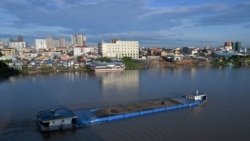Cambodia is basing hopes for a post-pandemic economic recovery on free trade agreements with China and South Korea, and membership in the Regional Comprehensive Economic Partnership.
RCEP is a free-trade agreement including the 10 members of the Association of Southeast Asian Nations, as well as China, Japan, South Korea, Australia and New Zealand that will come into effect Jan. 1. RCEP trade pact member countries will have a combined gross domestic product of $26.2 trillion, or about 30% of global GDP.
Analysts said Phnom Penh had aggressively pursued these trade deals amid the crushing economic impact of the COVID-19 pandemic and withdrawal of some trade perks by the European Union prompted by Cambodia’s human rights and democratic record.
Planning Minister Chhay Than has said more than 6 million jobs in the informal economy have been lost or will be lost due to COVID-19, and the United Nations Development Program expects Cambodia’s poverty rate could double to 17.6% of the population this year.
“They’re absolutely vital to Cambodia’s economic future. The markets for Cambodia in the next several years are going to be primarily its neighboring countries,” said Bart Edes, senior associate at the Center for Strategic and International Studies in Washington.
Cambodia’s economy has rapidly evolved since the end of 30 years of war in 1998, with Phnom Penh moving firmly into China’s orbit over the last decade. Two-way trade topped $8 billion in 2020 and is expected to reach $10 billion in 2023 with October's signing of the FTA.
A similar agreement was also inked with South Korea after two-way trade reached $880 million in 2020. Under that deal Cambodia will lift tariffs on 93.8% of all products traded, and South Korea will remove tariffs on 95.6% of all items.
RCEP will eliminate up to 90% of tariffs on goods traded between signatories over the next 20 years, which analysts said would further underpin regional integration by building upon China’s Belt and Road Initiative infrastructure projects.
Edes said the world’s booming economies are disproportionately located in Asia, where Cambodia is strategically positioned as a regional hub among much bigger neighbors Thailand, Vietnam, and the rest of ASEAN, making it an attractive investment destination.
“It’s not just China, it’s other countries in Asia. But these trade agreements, by having rules to the game are very important to Cambodia, these are positive moves for the country, for the people and for the economy and job opportunities,” he said.
Just 20% of Cambodia’s workforce is employed in the formal economy and the remaining 80%, which includes farmers, work in the informal economy, government sources said.
Thirty percent of Cambodians live on or just above the poverty line of $1.90 a day.
The situation was not helped by the withdrawal of some EU trade benefits under its Everything But Arms policy in August of last year, which tied tariff-free access to European markets to ensuring standards of democracy.
Brendan Lalor, a director with Ernst & Young in Cambodia, said the loss of tariff-free access for some goods, such as garments, to the EU and the pandemic had spurred the government into ratifying FTAs.
“With the FTA coming into effect obviously all your import tariffs, quotas, taxes, export restrictions all fall away so that should stimulate further bilateral trade between the two countries,” he said, referring to the FTAs with China and South Korea.
“So there is every chance that an FTA with Korea and China should offset the effects of the partial removal of the EBA,” he said, referring to the EU policy, adding Cambodia was ideally placed to take advantage of RCEP and cross-border trade.
Prime Minister Hun Sen has also said he wants an FTA with Russia.
Cambodia exports include garments, footwear and other apparel, travel products, beverages, electrical and electronic components, pharmaceuticals and agricultural products ranging from rubber to palm oil, cassava and cashews.
Under RCEP, Commerce Minister Pan Sorasak forecast the Cambodian GDP would grow by 2%, with exports up by 7.3% and investment by 23.4% with the elimination of tariffs on 90% of goods traded among signatories over the next 20 years.
“The RCEP agreement will become the core foundation for trade and investment in the region, further expand regional value chains and create more employment and market opportunities for peoples and businesses in the region,” he told Parliament.
However, Wim Conklin, country program director for the Solidarity Center in Cambodia, sounded a note of caution, warning FTAs and RCEP could result in a flood of cheaper goods coming into this country, including plastics, batteries and small household appliances.
“Overall, there could be some positive benefit but at the same time who benefits is always a question,” he said. “A much bigger country having a free trade agreement with another country is never going to be a real level playing field.”
He said FTAs had to be achieved for the benefit of the whole population, as opposed to specific sectors, such as banks and financial services, but he added that cheaper imports could provide a boost for producers and that in turn could benefit workers.
“Will that mean they might get higher wages because greater profits’ being made or certain costs are going down? We hope that might be the case but I’m not sure,” he said.











